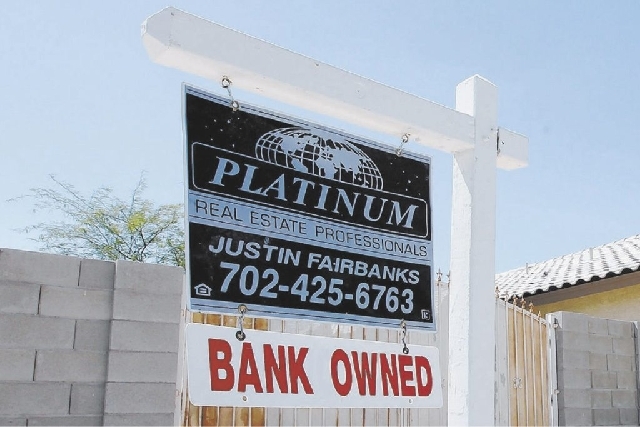Study: 54.3 percent of valley homeowners under water
As the recession recedes, Southern Nevada has fewer under-water homes.
But hundreds of thousands of local households are still drowning in a sea of negative equity, and numbers from online real estate database Zillow show which neighborhoods are most submerged.
Before drilling down into stats from specific communities, consider marketwide numbers. Zillow’s Negative Equity Report compared outstanding loan balances reported by credit bureau TransUnion to the homes’ current estimated value. The study found that 54.3 percent of valley homeowners owed more in the first quarter than their home was worth. That amounted to 181,237 homes with a total negative equity of $17.6 billion.
The share of under-water homes was down from 59.2 percent in the fourth quarter. The figure also roughly tracked March numbers from real estate analysis firm CoreLogic, which ranked Nevada the most under-water state, at 52.4 percent of households. Nationally, 25.4 percent of homes had negative equity.
The latest local figure is an improvement over the fourth quarter of 2011, when Zillow found that 70 percent of locals were upside down.
But this rising tide hasn’t lifted all boats.
In the valley’s northwest, northeast, east and central sections, negative equity still reigns. North Las Vegas continues to struggle as well. Consider ZIP code 89030 in North Las Vegas, where nearly 74 percent of homes were under water in the first quarter. In ZIPs 89031, 89081 and 89086, also in North Las Vegas, the share of homes with negative equity ranged from 63 percent to 68.1 percent. Almost 72 percent of homes in downtown’s 89101 ZIP were upside down, as were 71.7 percent of homes in the northeast’s 89115 ZIP.
At the same time, masterplans such as Summerlin, Green Valley and Anthem have seen negative equity fall below 50 percent. Overall, Summerlin posted the lowest percentage of under-water households. In the community’s 89134, 89135 and 89144 ZIP codes, negative equity affected 29.3 percent to 39.8 percent of homeowners. In 89052, the ZIP code that contains Anthem, 35.4 percent of homes were under water. And fewer than half of homes in ZIP codes that house Green Valley and Green Valley Ranch were upside down.
Local observers say several factors explain the disparate recoveries.
For starters, many consumers prefer master plans, especially those near freeways and other features, said Brian Gordon of housing research firm SalesTraq.
Plus, as prices crashed in the downturn, those master plans became more affordable, said Dave Tina, president of the Greater Las Vegas Association of Realtors. Thanks to that blend of location and affordability, demand surged and outstripped availability, Gordon said. That pushed up appreciation in 2012 by more than 18 percent in some parts of Summerlin, and more than 20 percent in Anthem, according to SalesTraq. Higher values left fewer people under water.
The popularity of master-planned communities hurt demand and values in the older northeast, east and central valley.
North Las Vegans are grappling with a different problem. Much of that city’s development happened during the peak pricing of 2004 to 2006, so households there have a long way to go before they return to their cost basis, Gordon said.
And some ZIP codes struggle with the burden of both older communities and recent economic troubles: 89011 includes mature, industrial neighborhoods around Boulder Highway and Pabco Road, but also the upscale Lake Las Vegas master plan, beset by bankruptcy and shuttered golf courses.
It’ll take time, but laggards should catch up with the market, experts said.
“Over the longer run, it becomes a function of supply and demand,” Gordon said. “With fewer homes available and prices continuing to escalate in more sought-after areas, buyers may migrate to surrounding neighborhoods, and you may see that spillover in any number of areas throughout the valley.”
That spillover should help more households in coming months. Zillow’s forecast calls for local negative equity to fall to 48.6 percent of households by the first quarter of 2014. That would mean an additional 19,262 homes would be worth more than their mortgage.
Even as negative equity loses ground to rising values, thousands of locals can expect to remain under water for years to come. Zillow reported that 29.2 percent of local households owed more than double what their home was worth, well above a national rate of 13.2 percent. That’s because so many people bought at the peak, Tina said.
That doesn’t necessarily mean a flood of homeowners walking away, though. The median existing home price was up more than 30 percent year over year in April, and negative equity is contracting so quickly that it could convince more borrowers to stick it out, Tina said.
“The normal homeowner hears the numbers and says, ‘Wow, maybe instead of bailing out, I stay and see what happens to my house,’” he said.
Added Gordon: “If they’ve weathered the storm to this point, they may be able to sustain their situation going forward.”
Contact reporter Jennifer Robison at jrobison@reviewjournal.com or 702-380-4512. Follow @J_Robison1 on Twitter.






















